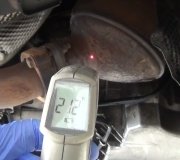The biggest mistake is a common one. The diagnostic fault codes did not say to replace the throttle position sensor. Fault codes never say to replace parts or that they're bad. They only indicate the circuit or system that needs further diagnosis, or the unacceptable operating condition. When a part is referenced in a fault code, it is actually the cause of that code only about half of the time. You first have to rule out wiring and connector problems which in this case are much more common.
Be aware too that Chrysler makes reading fault codes yourself much easier than any other manufacturer. Cycle the ignition switch from "off" to "run" three times within five seconds without cranking the engine, leave it in "run", then watch the codes show up in the odometer display.
The reason live data is so valuable is because what you're describing is one symptom of a failing MAP sensor or a vacuum leak. The acceptable range of signal voltage is approximately 0.5 to 4.5 volts. Anything outside that range will trigger a fault code. The problem is a sensor that's just starting to fail can report the WRONG value that's still within that acceptable range. No fault code will be set but since a tenth of a volt change has a big effect of fuel metering calculations, an incorrect signal voltage will have a big effect on engine performance.
In the late '80s and early '90s MAP sensor failures were real common but they rarely took more than a few hours to go from poor engine performance to a total no-start condition. Once the sensor was redesigned, failures are not very common. I'd expect first to find a wiring problem, but that would set a fault code that would turn on the Check Engine light. Since the sensor's signal voltage isn't going out of range, I think I'd start by looking for a vacuum leak.
As far as injectors, that should be the last thing on your list of suspects. GM has a lot of trouble on high-mileage engines with mismatched injectors. Chrysler buys theirs from Bosch in flow-matched sets and they have extremely little trouble with them. Measuring resistance values isn't likely to identify a problem either. If one is partially-shorted, you might develop a misfire, which the Engine Computer would detect, and again, turn on the Check Engine light. All of them aren't going to fail at the same time so if you suspect a fuel-related cause, look to pressure and volume. Those aren't likely to be the cause here either because those typically cause stalling when the largest volume of fluid is flowing, which is, ... During coasting.
Monday, March 30th, 2015 AT 5:39 PM



